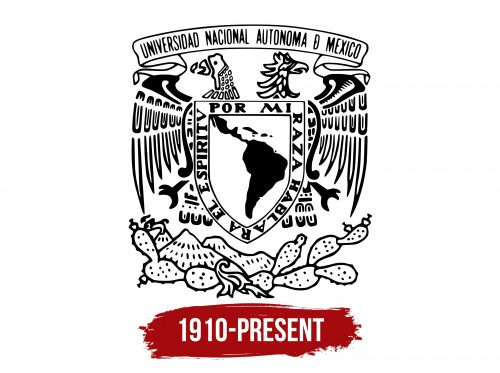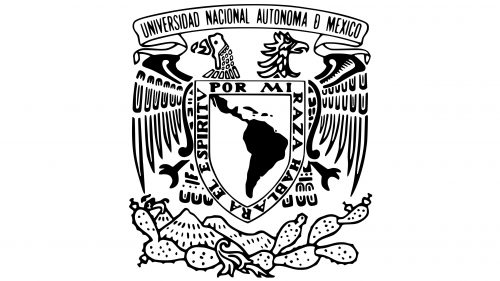The UNAM logo can rightfully be called informative, multifaceted, and remarkably presentable. It combines images, text, and each element, carefully drawn with its symbolic meaning. This logo is like a book to be read, with admiration for each illustration and its unique symbols. This makes the logo of the largest educational institution in the Americas unique. It is an original symbol that has existed for a long time and is the best representation of the most prestigious university in Latin America.
From a graphic perspective, the logo impresses with its arrangement of figures and elements, emphasizing UNAM’s status as a leading research institution. It positions the university as a center of theoretical knowledge and an organization offering practical training. The courses and programs developed at UNAM aim to develop specialists in various fields, making this logo a symbol of educational and scientific excellence.
UNAM: Brand overview
Mexico’s colonial era is when the National Autonomous University of Mexico (Universidad Nacional Autónoma de México, UNAM) had its start. Its origins date back to 1551 when Spanish King Charles V issued an edict establishing the Royal and Pontifical University of Mexico (Real y Pontificia Universidad de México). The first university to be founded in North America was this one.
The institution was essential to the elite of New Spain’s education throughout the colonial era. It was greatly influenced by the Spanish Crown and the Catholic Church and prepared priests, attorneys, and administrators for the colonial system.
Unrest followed Mexico’s independence in 1821. Liberal regimes saw it as a bastion of colonialism and conservatism. The institution was briefly shut down in 1833 and then underwent multiple reorganizations.
The National University of Mexico was established in 1910 when the Mexican Revolution began. This occasion marked a critical turning point in the nation’s higher education reform process. The then-Minister of Education, Justo Sierra, was a major contributor to the establishment of the new university, which became a hub of Mexican scientific and cultural life.
An important turning point in the university’s history was its attainment of autonomy in 1929. This was vital for academic freedom since it allowed the institution to run its internal affairs independently. After this, the university was called the National Autonomous University of Mexico (UNAM).
In the 1930s and 1940s, the institution experienced rapid expansion. The faculty and program expansions led to increased enrollment. During this time, the institution became a haven for many intellectuals from Spain who were escaping Franco’s government, enhancing the academic life of the university.
In Mexico City’s Coyoacán neighborhood, the institution’s new campus began developing in the 1950s. Ciudad Universitaria, or University City, is the project that eventually became one of the most ambitious architectural endeavors in Mexican history. The campus opened in 1954 and had several buildings decorated with murals by well-known Mexican artists, representing the nation’s modernity.
As in many other colleges worldwide, the 1960s were turbulent for students at the university. The events of 1968, when the government violently ended student protests, deeply impacted Mexico’s political and social world.
The university expanded and changed over the 1970s and 1980s, forming new research centers and faculties. The institution was vital to the nation’s cultural life, supporting art, literature, and music.
The institution faced new obstacles throughout the 1990s. In 1999–2000, a protracted student strike opposed plans to increase tuition, leading to major adjustments in the institution’s management.
Early in the twenty-first century, the university continued to enhance its standing as the top institution in Latin America. New research initiatives were started, and international linkages were strengthened.
The university’s main campus was recognized for its cultural and architectural significance when it was named a UNESCO World Heritage Site in 2007.
In 2008, the institution commemorated the centennial of its restoration as the National University. Numerous scholarly and artistic events highlighted the university’s contribution to Mexico’s growth.
In 2010, an extensive endeavor to revamp the research infrastructure started. Modern, equipment-equipped laboratories and research institutes were constructed.
In 2011, the institution launched new offices abroad, particularly in China and France, increasing its international engagement and foreign student enrollment.
A noteworthy accomplishment in astronomy occurred in 2013: the university’s space research was instrumental in identifying the first planet in the habitable zone around the star Kepler-69c.
In 2015, the institution introduced a comprehensive digital education initiative. New online courses and creative distance learning techniques broadened access to education.
A new campus in Mérida, Yucatán, was inaugurated in 2016. This campus focuses on biotechnology research and sustainable development, increasing the institution’s reach throughout Mexico.
In 2018, the institution improved its standing in global university rankings, reaching the top 100 in several subjects, including engineering and the natural sciences.
2019, a new initiative to advance robotics and artificial intelligence research was introduced. A dedicated center assembled specialists from multiple academic departments.
In 2020, the institution expanded its virtual research and online learning capabilities in response to global challenges.
The year 2021 saw substantial growth in student social support programs. Scholarships were expanded, and new forms of financial aid were developed to guarantee access to education.
On its 100th anniversary in 2022, the institution commemorated the establishment of its symbol and motto, “Por mi raza hablará el espíritu” (The spirit shall speak through my race). Numerous intellectual and cultural events marked this milestone.
To fulfill its mission, the institution supported many theaters, museums, and other cultural establishments. As a result, it became a major hub for art and culture for students and the larger Mexican community.
The university has been a focal point of Mexican intellectual and cultural life. Numerous notable individuals in science, art, and politics have emerged from the university, including multiple Mexican presidents and Nobel Prize winners.
As a result, Mexico’s history and the university’s history are strongly entwined, with the institution’s past reflecting Mexico’s colonial era, independence struggle, revolutionary reforms, and contemporary progress. The university has played a major role in Mexico’s education and development since its founding as a colonial institution and contemporary research university.
Meaning and History
What is UNAM?
This university, located in Mexico City, is the country’s largest and most respected public institution. It offers various academic programs in the humanities, social sciences, natural sciences, arts, and other fields. The university’s main campus, Ciudad Universitaria, recognized as a UNESCO World Heritage Site, features murals by famous Mexican artists and iconic architecture. The university is one of the best in Latin America, has a huge student body, an excellent staff, and a long history of producing important figures in Mexican politics, science, and culture.
1910 – today
The university, which has produced three Nobel laureates, has managed to preserve its authentic identity from its founding to the present. This demonstrates a commitment to tradition, continuous development, and the fundamental nature of the knowledge being taught. The Universidad Nacional Autónoma de México ranks among the world’s top five most renowned universities and annually graduates the most sought-after specialists in various fields.
The university’s logo cannot be described as simple by any standard. It contains deep information about the key characteristics and achievements of the institution, symbolizing the foundation and significance of the knowledge imparted here.
The logo’s elegance is evident, with clear motifs of patriotism and aristocracy. It is associated with the Universidad Nacional Autónoma de México and also serves as the coat of arms of Mexico City. At the top of the logo, the phrase “Por mi raza hablará el espíritu” (“The spirit will speak for my race”) shines majestically, emphasizing the importance of truth and the university’s serious intentions.
Two birds harmonize the overall design, symbolizing knowledge and freedom. Despite their asymmetry, the birds appear majestic, evoking the image of guardians of knowledge. These details add significance and depth to the logo.
The lower part of the logo expands the narrative, depicting hills and cacti, symbolizing another reality—Mexico’s past and present. While the logo lacks dynamism, there is a clear sense of the passage of time, linking tradition with modernity.
The university has also preserved its original seal, which can be rendered in gold or blue tones, underscoring the value of UNAM’s heritage and its significance on a global scale.





